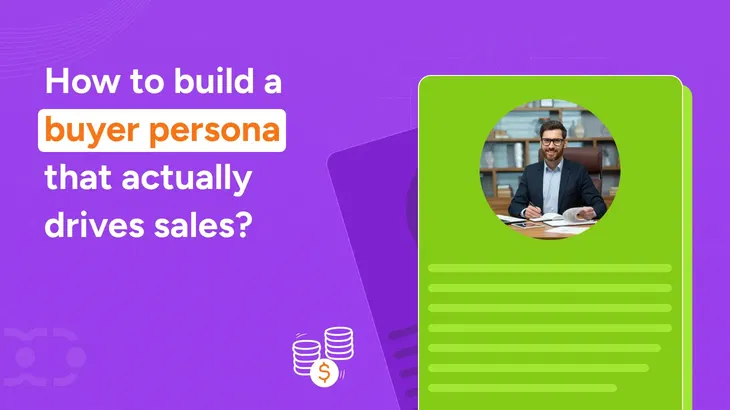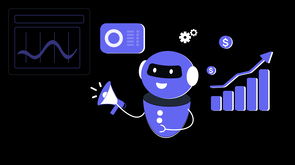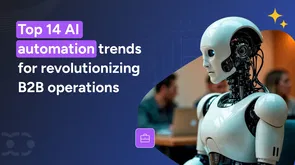Ever seen an ad that felt like it was reading your mind? That's not luck—it's strategy.
Businesses that cast a wide net, relying on generic marketing messages, struggle to reach their target audience.
Nowadays, clients expect brands to understand their needs, challenges, and decision-making processes.
And the numbers prove it: Customer-centric companies tend to be 60% more profitable than those that aren't.
This is where buyer personas come in.
A well-defined persona helps you craft laser-focused marketing that speaks directly to the right audience—turning prospects into loyal customers.
So, what does buyer persona mean, and how do you build one that drives sales?
Let's break it down.
What is a buyer persona?
A buyer persona is a research-backed, semi-fictional profile of your ideal customer. It is called by other names - Customer persona, audience persona, or marketing persona.
A detailed buyer persona goes beyond basic demographics. It explores prospective customers' motivations, pain points, and buying behaviors to help you craft hyper-targeted marketing and sales strategies.
This strategic tool acts as a brand roadmap, helping them connect with the right people at the right time.
The result? Better engagement, higher conversions, and stronger customer relationships.
Here's an example to understand better:
Marketing without vs. with a buyer persona
Imagine running an ad campaign for fitness products:
- Without a buyer persona - Targeting a broad audience, wasting your budget on people who aren't interested in fitness.
- With a buyer persona – Crafting a strategy around "Health-Conscious Ron," a 35-year-old professional who values convenience and efficiency in her workouts. Your messaging now speaks directly to her, increasing engagement and conversions.
Buyer persona in digital marketing and sales makes a huge difference.
Let's move to understand why buyer personas are important.
Key benefits of creating buyer personas
Creating buyer personas is a strategic approach that enhances marketing efforts. It helps improve customer acquisition and ensures cross-department alignment between marketing, sales, and customer support.
Here are some key benefits, supported by buyer persona examples, illustrating how businesses can craft more effective strategies.
1. Better-informed sales efforts
Buyer personas clearly understand your target audience's needs, preferences, and challenges, allowing your sales team to craft messaging that resonates.
For instance, if the persona is "Tech-Savvy Tom," a 40-year-old IT manager, the sales team can emphasize seamless system integration and efficiency improvements, addressing his specific concerns and increasing the likelihood of conversion.
So, instead of a generic sales pitch, they can develop tailored approaches that directly address customer pain points and buying motivations.
2. Improved customer acquisition and retention
Marketing campaigns become more effective when they align with the specific needs and behaviors of well-researched buyer personas.
Understanding what motivates potential customers enables businesses to create content and experiences that engage the right audience.
For example, "Eco-Friendly Emma," a 30-year-old sustainability advocate, would be more inclined to buy from brands that emphasize environmentally responsible practices.
Therefore, with defined personas, the team can create marketing campaigns highlighting unique selling points that appeal to customers' interests.
3. Cross-department alignment
Buyer personas bridge the gap between marketing, sales, and product teams by establishing a shared understanding of the ideal customer.
This alignment ensures consistency in messaging, product development, and customer experience.
When every department operates with a unified approach, decision-making becomes more data-driven and customer-centric.
Buyer persona vs. target market vs. customer segments
Many businesses mix up these terms, but understanding their differences is crucial for effective marketing.
The table below will help you understand the difference:
| Aspect | Buyer persona | Target market | Customer segments |
| Definition | A detailed profile of an ideal customer with behavioral insights | A broad group of people who fit your product/service | A subset of your target market with shared traits |
| Focus | Psychographics, motivations, behaviors | Demographics & industry trends | More specific pain points & needs |
| Example | “Sarah, a 35-year-old HR manager struggling with employee retention” | “Mid-sized businesses looking for HR solutions” | “HR managers in tech companies with high turnover” |
In summary, a target market tells you who you serve, and customer segmentation refines that focus.
However, a buyer persona makes it actionable by revealing what drives your customers' decisions. Without it, marketing remains too broad and ineffective.
Now that you understand the meaning of a buyer persona, let's discuss how to create one that truly impacts your business.
How to create a buyer persona in five simple steps
Creating a buyer persona without data is like shooting in the dark. You must base your persona on real insights to truly connect with your audience.
Here's how to build one that actually drives sales.
Step 1: Gather data from the right sources
Your buyer persona is only as strong as the data behind it. Relying on assumptions leads to generic marketing that fails to engage.
The study found that 56% of consumers are open to sharing personal data for better service.
So, to create detailed buyer personas, you need to gain insights, and the below tactics will help you in this:
- Customer surveys & interviews: One-on-one calls, surveys, and social listening uncover pain points and expectations.
- CRM & analytics data: Tools like Google Analytics and Customer Relationship Management Solution (CRM) reveal target customer behavior and trends.
- Social media insights: Platforms like Facebook Audience Insights and LinkedIn Analytics offer interest-based segmentation.
- Sales and customer support feedback: Frontline teams frequently hear objections, feature requests, and hesitations, so they gather all customer feedback.
- Internal teams: The Sales, marketing, and customer success teams interact with customers the most, and their input is invaluable.
Note that buyer persona research is the key to building accurate profiles that reflect real customer needs and behaviors.
Step 2: Identify key persona characteristics
Once you have data, the next step is structuring it into a detailed persona profile. A great buyer persona goes beyond demographics and dives into behaviors, motivations, and decision-making processes.
- Basic details – Name, Age, Job Title, Location, Industry
- Behavioral insights – Buying habits, challenges, and decision-making triggers
- Psychographics – Values, motivations, and preferred communication channels
For instance, "Freelance Designer David" prefers in-depth product comparisons, while "Marketing Manager Gracy" responds better to social proof and case studies.
Here are the key persona characteristics to consider:
Step 3: Find common patterns & segment personas
Not all customers think alike; a hairstylist selecting L'Oréal's pro range focuses on quality, while a retail shopper may prioritize price and availability.
So, grouping them into distinct personas allows for more personalized marketing.
- Identify common pain points: What challenges do they face? How does your product solve them?
- Avoid generic personas: Broad personas weaken targeting. Keep segmentation data-backed and specific.
- Match personas to the customer journey: Ensure you have personas for early-stage, mid-stage, and late-stage buyers.
Manually segmenting customers can be overwhelming, especially when dealing with diverse buyer personas across multiple channels.
Salesmate CRM simplifies this process with its Contact Segmentation, which enables businesses to automatically categorize leads based on behaviors, demographics, and interactions.
Step 4: Create a story-driven persona profile
Once you have segmented your personas, it's time to turn them into something tangible.
A persona isn't just a list of attributes—it's a story that helps marketers and sales teams visualize the ideal customer.
- Give them a name & image: Humanize the persona to make it relatable.
- Define their pain points & decision triggers: What makes them choose your product?
- Highlight content preferences: Blogs? Webinars? Case studies? What do they engage with?
- Include a buyer's journey snapshot: What steps do they take before purchasing?
Here's what an ideal B2B buyer persona looks like:
Step 5: Validate & continuously improve personas
A common mistake is treating buyer personas as a "set-it-and-forget-it" exercise. Instead, effective buyer persona development is an ongoing process.
Your customers evolve, and so should your personas.
- Test different messaging & offers: A/B test headlines, CTAs, and content to see what resonates.
- Track performance metrics: Monitor conversion rates, engagement levels, and feedback.
- Refine personas quarterly: Update personas as new data emerges to keep them relevant.
To simplify the process, businesses can use buyer persona templates that provide a structured framework for collecting and organizing customer data.
These templates help define target audiences effectively and ensure consistency across marketing efforts.
Want to build a persona that actually converts?
Get a proven framework for creating buyer personas that drive engagement and sales.
Decoding buyer behavior: The psychology behind personas that sell
Understanding why people buy is just as important as knowing who they are.
While demographics tell you who your customers are, psychology reveals what drives their decisions.
Every purchase—whether in B2C or B2B—is influenced by emotions, motivations, and cognitive triggers.
Brands that align their marketing with these psychological factors create stronger connections and drive conversions.
The psychological triggers that shape buying decisions
People don't just buy products; they buy solutions, a sense of belonging, or a way to enhance their identity.
Whether a luxury brand offers exclusivity or a SaaS company simplifies workflows, every successful marketing strategy taps into core psychological triggers.
Here are the key psychological factors that influence purchasing decisions:
1. Fear of missing out (FOMO)
Scarcity and exclusivity create urgency. When people feel they might miss out, they act faster.
For instance, eCommerce brands use countdown timers and "Only X left in stock" alerts to drive impulse purchases.
Explore: A comprehensive guide to eCommerce marketing automation
2. Trust and credibility
People buy from brands they trust. Whether it's a B2B software provider or a direct-to-consumer brand, credibility is built through consistency, expertise, and transparency.
SaaS companies showcase testimonials, case studies, and product comparisons to reduce hesitation and validate their value.
3. Social proof and influence
Humans are wired to seek social validation. When they see others using and endorsing a product, they feel more confident in their purchase decision.
As Robert Cialdini explains in Influence: The Psychology of Persuasion,
"We view a behavior as more correct in a given situation to the degree that we see others performing it."
This principle is why brands leverage reviews, testimonials, and influencer marketing.
Apple, for example, doesn't just advertise its features—it builds trust through customer stories, unboxing videos, and endorsements from tech experts.
4. Ease and convenience
The easier the buying process, the more likely customers are to convert. A complicated checkout flow, unnecessary friction, or too many options can lead to abandoned carts and lost sales.
Amazon's one-click checkout and Netflix's frictionless onboarding are prime examples of how convenience directly impacts conversions.
How brands use psychology to shape their buyer personas?
The most successful brands don't just sell products—they sell aspirations, emotions, and experiences.
Buyer personas help them shape their messaging to align with psychological triggers.
- Apple attracts tech-savvy buyers who value innovation, exclusivity, and seamless integration. Every iPhone launch creates anticipation, reinforcing a sense of belonging for Apple users.
- Nike taps into motivation and empowerment. Its "Just Do It" campaign speaks directly to athletes and fitness enthusiasts who see sports as more than just a game—it's a mindset.
- Tesla fuels FOMO and exclusivity by offering limited production runs and long waitlists, making customers feel they are part of an elite group.
Understanding the psychology behind buyer personas allows you to craft targeted marketing that feels personal and relevant.
You can build trust, engage your audience, and increase conversions by leveraging customer insights and psychological triggers.
Want to turn buyer personas into real sales?
Capture, segment, and convert leads effortlessly with AI-assisted insights, smart automation, and multi-channel communication—all in one platform.
Closing thoughts
A well-defined buyer persona transforms generic marketing into personalized experiences that drive engagement and sales.
But personas aren't static. As customer behavior, market trends, and technology evolve, so should your personas.
To keep them relevant:
- Test messaging and offers with A/B testing.
- Monitor engagement and conversion rates to see how personas respond.
- Refine personas regularly based on customer insights and analytics.
Businesses that update their personas consistently generate twice as many leads as those that don't.
Frequently asked questions
1. What is the difference between a buyer persona and an ideal customer profile (ICP)?
An Ideal Customer Profile (ICP) defines the type of company that benefits most from your product or service, focusing on attributes like industry, size, and budget.
On the other hand, a buyer persona represents the specific decision-makers within that company, detailing their challenges, motivations, and decision-making process.
2. How many buyer personas does a business need?
The number of buyer personas depends on the diversity of your audience. Most businesses have at least 2-3 personas representing key customer segments. Too many personas can complicate targeting, while too few may lead to generic messaging.
3. How do you create a buyer persona without existing customers?
Start with market research, competitor analysis, and industry reports. Then, surveys or interviews with potential customers will be conducted to gather insights about their needs and behaviors. Social media listening and online forums can also provide valuable pain points and preferences data.
4. What are the key components of a good buyer persona?
- Demographics: Age, location, job role, and income.
- Psychographics: Interests, values, and motivations.
- Challenges & pain points: Problems they need to solve.
- Buying behavior: Decision-making factors, preferred channels.
- Communication preferences: Social media, email, or content format preferences.
5. How often should buyer personas be updated?
Personas should be reviewed at least once a year or when there is a major shift in customer behavior, industry trends, or product offerings. Regular updates ensure that your marketing stays relevant and aligned with audience needs.
6. How do buyer personas help improve marketing campaigns?
Buyer personas enable precise targeting by aligning messaging with customer needs. They help personalize content, refine ad strategies, and improve conversion rates by focusing on what truly matters to your audience.







Key takeaways
Ever seen an ad that felt like it was reading your mind? That's not luck—it's strategy.
Businesses that cast a wide net, relying on generic marketing messages, struggle to reach their target audience.
Nowadays, clients expect brands to understand their needs, challenges, and decision-making processes.
And the numbers prove it: Customer-centric companies tend to be 60% more profitable than those that aren't.
This is where buyer personas come in.
A well-defined persona helps you craft laser-focused marketing that speaks directly to the right audience—turning prospects into loyal customers.
So, what does buyer persona mean, and how do you build one that drives sales?
Let's break it down.
What is a buyer persona?
A buyer persona is a research-backed, semi-fictional profile of your ideal customer. It is called by other names - Customer persona, audience persona, or marketing persona.
A detailed buyer persona goes beyond basic demographics. It explores prospective customers' motivations, pain points, and buying behaviors to help you craft hyper-targeted marketing and sales strategies.
This strategic tool acts as a brand roadmap, helping them connect with the right people at the right time.
The result? Better engagement, higher conversions, and stronger customer relationships.
Here's an example to understand better:
Marketing without vs. with a buyer persona
Imagine running an ad campaign for fitness products:
Buyer persona in digital marketing and sales makes a huge difference.
Let's move to understand why buyer personas are important.
Key benefits of creating buyer personas
Creating buyer personas is a strategic approach that enhances marketing efforts. It helps improve customer acquisition and ensures cross-department alignment between marketing, sales, and customer support.
Here are some key benefits, supported by buyer persona examples, illustrating how businesses can craft more effective strategies.
1. Better-informed sales efforts
Buyer personas clearly understand your target audience's needs, preferences, and challenges, allowing your sales team to craft messaging that resonates.
For instance, if the persona is "Tech-Savvy Tom," a 40-year-old IT manager, the sales team can emphasize seamless system integration and efficiency improvements, addressing his specific concerns and increasing the likelihood of conversion.
So, instead of a generic sales pitch, they can develop tailored approaches that directly address customer pain points and buying motivations.
2. Improved customer acquisition and retention
Marketing campaigns become more effective when they align with the specific needs and behaviors of well-researched buyer personas.
Understanding what motivates potential customers enables businesses to create content and experiences that engage the right audience.
For example, "Eco-Friendly Emma," a 30-year-old sustainability advocate, would be more inclined to buy from brands that emphasize environmentally responsible practices.
Therefore, with defined personas, the team can create marketing campaigns highlighting unique selling points that appeal to customers' interests.
3. Cross-department alignment
Buyer personas bridge the gap between marketing, sales, and product teams by establishing a shared understanding of the ideal customer.
This alignment ensures consistency in messaging, product development, and customer experience.
When every department operates with a unified approach, decision-making becomes more data-driven and customer-centric.
Buyer persona vs. target market vs. customer segments
Many businesses mix up these terms, but understanding their differences is crucial for effective marketing.
The table below will help you understand the difference:
In summary, a target market tells you who you serve, and customer segmentation refines that focus.
However, a buyer persona makes it actionable by revealing what drives your customers' decisions. Without it, marketing remains too broad and ineffective.
Now that you understand the meaning of a buyer persona, let's discuss how to create one that truly impacts your business.
How to create a buyer persona in five simple steps
Creating a buyer persona without data is like shooting in the dark. You must base your persona on real insights to truly connect with your audience.
Here's how to build one that actually drives sales.
Step 1: Gather data from the right sources
Your buyer persona is only as strong as the data behind it. Relying on assumptions leads to generic marketing that fails to engage.
The study found that 56% of consumers are open to sharing personal data for better service.
So, to create detailed buyer personas, you need to gain insights, and the below tactics will help you in this:
Note that buyer persona research is the key to building accurate profiles that reflect real customer needs and behaviors.
Step 2: Identify key persona characteristics
Once you have data, the next step is structuring it into a detailed persona profile. A great buyer persona goes beyond demographics and dives into behaviors, motivations, and decision-making processes.
For instance, "Freelance Designer David" prefers in-depth product comparisons, while "Marketing Manager Gracy" responds better to social proof and case studies.
Here are the key persona characteristics to consider:
Step 3: Find common patterns & segment personas
Not all customers think alike; a hairstylist selecting L'Oréal's pro range focuses on quality, while a retail shopper may prioritize price and availability.
So, grouping them into distinct personas allows for more personalized marketing.
Manually segmenting customers can be overwhelming, especially when dealing with diverse buyer personas across multiple channels.
Salesmate CRM simplifies this process with its Contact Segmentation, which enables businesses to automatically categorize leads based on behaviors, demographics, and interactions.
Step 4: Create a story-driven persona profile
Once you have segmented your personas, it's time to turn them into something tangible.
A persona isn't just a list of attributes—it's a story that helps marketers and sales teams visualize the ideal customer.
Here's what an ideal B2B buyer persona looks like:
Step 5: Validate & continuously improve personas
A common mistake is treating buyer personas as a "set-it-and-forget-it" exercise. Instead, effective buyer persona development is an ongoing process.
Your customers evolve, and so should your personas.
To simplify the process, businesses can use buyer persona templates that provide a structured framework for collecting and organizing customer data.
These templates help define target audiences effectively and ensure consistency across marketing efforts.
Want to build a persona that actually converts?
Get a proven framework for creating buyer personas that drive engagement and sales.
Decoding buyer behavior: The psychology behind personas that sell
Understanding why people buy is just as important as knowing who they are.
While demographics tell you who your customers are, psychology reveals what drives their decisions.
Every purchase—whether in B2C or B2B—is influenced by emotions, motivations, and cognitive triggers.
Brands that align their marketing with these psychological factors create stronger connections and drive conversions.
The psychological triggers that shape buying decisions
People don't just buy products; they buy solutions, a sense of belonging, or a way to enhance their identity.
Whether a luxury brand offers exclusivity or a SaaS company simplifies workflows, every successful marketing strategy taps into core psychological triggers.
Here are the key psychological factors that influence purchasing decisions:
1. Fear of missing out (FOMO)
Scarcity and exclusivity create urgency. When people feel they might miss out, they act faster.
For instance, eCommerce brands use countdown timers and "Only X left in stock" alerts to drive impulse purchases.
2. Trust and credibility
People buy from brands they trust. Whether it's a B2B software provider or a direct-to-consumer brand, credibility is built through consistency, expertise, and transparency.
SaaS companies showcase testimonials, case studies, and product comparisons to reduce hesitation and validate their value.
3. Social proof and influence
Humans are wired to seek social validation. When they see others using and endorsing a product, they feel more confident in their purchase decision.
As Robert Cialdini explains in Influence: The Psychology of Persuasion,
"We view a behavior as more correct in a given situation to the degree that we see others performing it."
This principle is why brands leverage reviews, testimonials, and influencer marketing.
Apple, for example, doesn't just advertise its features—it builds trust through customer stories, unboxing videos, and endorsements from tech experts.
4. Ease and convenience
The easier the buying process, the more likely customers are to convert. A complicated checkout flow, unnecessary friction, or too many options can lead to abandoned carts and lost sales.
Amazon's one-click checkout and Netflix's frictionless onboarding are prime examples of how convenience directly impacts conversions.
How brands use psychology to shape their buyer personas?
The most successful brands don't just sell products—they sell aspirations, emotions, and experiences.
Buyer personas help them shape their messaging to align with psychological triggers.
Understanding the psychology behind buyer personas allows you to craft targeted marketing that feels personal and relevant.
You can build trust, engage your audience, and increase conversions by leveraging customer insights and psychological triggers.
Want to turn buyer personas into real sales?
Capture, segment, and convert leads effortlessly with AI-assisted insights, smart automation, and multi-channel communication—all in one platform.
Closing thoughts
A well-defined buyer persona transforms generic marketing into personalized experiences that drive engagement and sales.
But personas aren't static. As customer behavior, market trends, and technology evolve, so should your personas.
To keep them relevant:
Businesses that update their personas consistently generate twice as many leads as those that don't.
Frequently asked questions
1. What is the difference between a buyer persona and an ideal customer profile (ICP)?
An Ideal Customer Profile (ICP) defines the type of company that benefits most from your product or service, focusing on attributes like industry, size, and budget.
On the other hand, a buyer persona represents the specific decision-makers within that company, detailing their challenges, motivations, and decision-making process.
2. How many buyer personas does a business need?
The number of buyer personas depends on the diversity of your audience. Most businesses have at least 2-3 personas representing key customer segments. Too many personas can complicate targeting, while too few may lead to generic messaging.
3. How do you create a buyer persona without existing customers?
Start with market research, competitor analysis, and industry reports. Then, surveys or interviews with potential customers will be conducted to gather insights about their needs and behaviors. Social media listening and online forums can also provide valuable pain points and preferences data.
4. What are the key components of a good buyer persona?
5. How often should buyer personas be updated?
Personas should be reviewed at least once a year or when there is a major shift in customer behavior, industry trends, or product offerings. Regular updates ensure that your marketing stays relevant and aligned with audience needs.
6. How do buyer personas help improve marketing campaigns?
Buyer personas enable precise targeting by aligning messaging with customer needs. They help personalize content, refine ad strategies, and improve conversion rates by focusing on what truly matters to your audience.
Sonali Negi
Content WriterSonali is a writer born out of her utmost passion for writing. She is working with a passionate team of content creators at Salesmate. She enjoys learning about new ideas in marketing and sales. She is an optimistic girl and endeavors to bring the best out of every situation. In her free time, she loves to introspect and observe people.